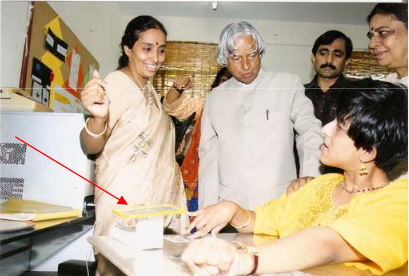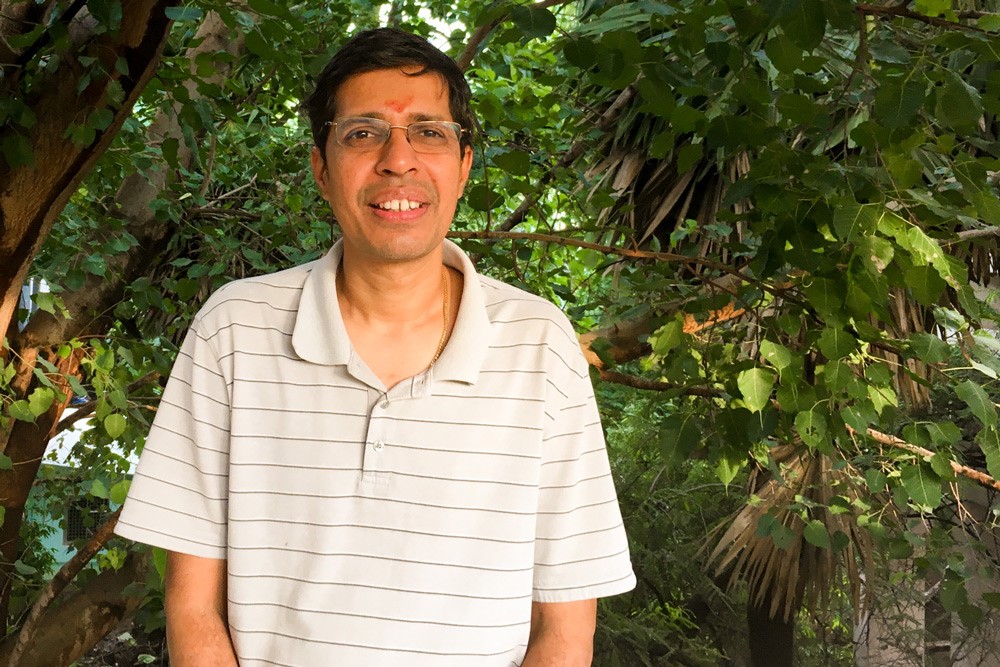ADITI is an indigenously developed non-contact switch that makes a computer accessible to individuals with motor impairments. The switch gets activated in the proximity of any part of the human body and works as the left click of a mouse.
The assistive device named ADITI
Dr. Namita Jacob, a special education expert, describes her experience of developing ADITI in coordination with the IITM faculty in the following article:
The design of an assistive technology requires an interdisciplinary team consisting of both rehabilitation workers and technology experts. The conversation between a rehab worker and a techie is usually filled with miscommunication and dissatisfaction.
Rehabilitation workers are unable to state a problem in clean technical terms. They focus on individuals and all their unique differences and rarely on the group. Hence, each suggested solution is met with a leap from one student to another and even from one issue to the other – solving a problem is like an ever-moving target – they seem to want the device to do everything for everyone.
In contrast, the techie sees everything in general, casually shedding details that mess up the ‘cool design idea’ and shrugging off practicalities that would move a device from ‘should work’ to ‘does work’. Once they reach the proof of concept stage, they lose interest and numerous excellent ideas lie incomplete, written up in CV’s but never changing the life of the person who inspired the idea in the first place.
A large part of my role has been in translating rehab English to techie English, and vice versa; keeping the focus of both groups on the target – really enabling the change we want to see in the lives of these individuals.
The creation of ADITI is what gave me the skills and the continued optimism in the face of numerous failed projects – to pursue the dream of a stream of brilliant, viable, solutions that could emerge from our work together. I was there when Nitin Chandrachoodan dropped by and showed Anil Prabhakar a link to the most awful sounding instrument – the THEREMIN. He was very excited about its design and wanted to recreate it in the form of a non-contact switch. As both of them discussed the cool principles involved, I grumbled that it was an entirely horrid creation of sound. And if it only did something useful like write with lights on the wall, or turn on the fan, it would have some value for the students, who had severe motoric impairment, whom I worked with. Oh that’s trivial, I was told and having heard this often before (and having never seeing the outcome), I said – well then, build it!
An artist playing the Theremin
Nothing happened for a while until Anil proposed it as a project to one of his students. Pretty soon, I was called into the lab to see a test drive of the device. It functioned as the left click of the mouse and suddenly – a giant need tossed off as a flippant remark – became a real possibility. I could immediately see the need for the small changes, insignificant and perhaps irritating from the perspective of the people who were designing it, but very important when it came to transforming it from an idea to a usable device. The first test of the device in the school (with none of the changes I requested) suddenly shifted the perspective. I still remember Thiruthakkathevan, the student in charge of the project and person who carried the device into the school, standing stricken as he watched children with impairments he had never imagined and amazed by the ability they demonstrated with the help of the device. He could barely believe it!
Students at Vidyasagar using the device
After this, it became easier to discuss changes and fine tune the design. I realized the importance of the entire design and technical team engaging directly with the end user. My role simply became that of the mediator or interpreter in the discussions that ensued. The senior students of the school became our testers, biggest critiques and design directors. Everyone from the faculty, students and technicians provided ideas and solutions.
ADITI is an adaptable non-contact switch
ADITI is brilliant because all accessible non-contact switches before this required the user to learn a particular way of activation. With ADITI, we could simply see how the individual moved and set the switch to respond to their existing movements. Over 90% of the children with whom we have tried ADITI learned to use it within one training session. This was all the proof we needed about its capability. The next few years went into fine tuning the device and an amazing partnership with Mindtree Foundation helped us bring professionalism and detail in the final design and marketing of ADITI.
ADITI was named for what it offered the end user – limitless possibilities – and the technology on which it was based on – Analog DIgital Touch Interphase. The name reminds us of the importance of working closely together to create what is truly brilliant, truly enabling – truly Aditi (Aditi literally means boundless).
Dr. APJ Abdul Kalam at a demonstration of ADITI
After ADITI’s success, students and staff at the Department of Electrical Engineering have undertaken a number of other projects. HOPE and KAVI were precursors to Avaz, and the Tactograph was a 2012 IEEE AIYEHUM awardee. More recently, iGest was recognized by the 2015 NASSCOM Social Innovation award. All these projects now come under the broader umbrella of a Centre for Rehabilitative and Assistive Technology (create.iitm.ac.in) and are being productized by Enability Foundation for Rehabilitation (enability.in) a Section 8 company incubated by IIT Madras.
India is signatory to the United Nations Convention on the Rights of People with Disabilities (UNCRPD) but it has not resulted in adequate change in opportunities and possibilities for the citizens in our country who have disabilities. Enabling Rights involves the Will of an entire Nation so that problem solving, innovation and dedication to change – all of which we as a Nation have shown to be our strengths – can be harnessed to bring about the change we have promised to enable. As with much in India, the problems exist right beside those that have the capacity to solve them, and all it takes is someone to build a bridge between.
Chetana Charitable Trust was established to bring about such connections and has made increasing effective access of people with disabilities to life and society a major goal of their work. Since 2003, several faculty and students of IIT Madras have worked with Chetana on many projects and slowly an increasing interest in disabilities and enabling technology led to the idea of offering a course on the subject of Assistive Technologies.
In addition to individual faculty and student projects, the assistive technology lab, Center for Innovation and R2D2 labs are all currently engaged in the development of assistive technology solutions designed for the reality of life in India. ADITI, a non-contact switch, word and sentence construction through Hope, picture to speech through KAVI, a standing wheelchair, a Tactograph (tactile graphics on demand) and iGest (an inertial motion unit device for communication and occupational therapy) are all examples of the high levels of innovation and creativity we are capable of as a Nation.
 Dr. Namita is special education consultant based in Chennai. She works with children with impairments. She introduced the ‘Assistive Technologies’ minor in the institute to increase awareness about accessibility. She is the director of Chetana Charitable Trust, Chennai.
Dr. Namita is special education consultant based in Chennai. She works with children with impairments. She introduced the ‘Assistive Technologies’ minor in the institute to increase awareness about accessibility. She is the director of Chetana Charitable Trust, Chennai.







